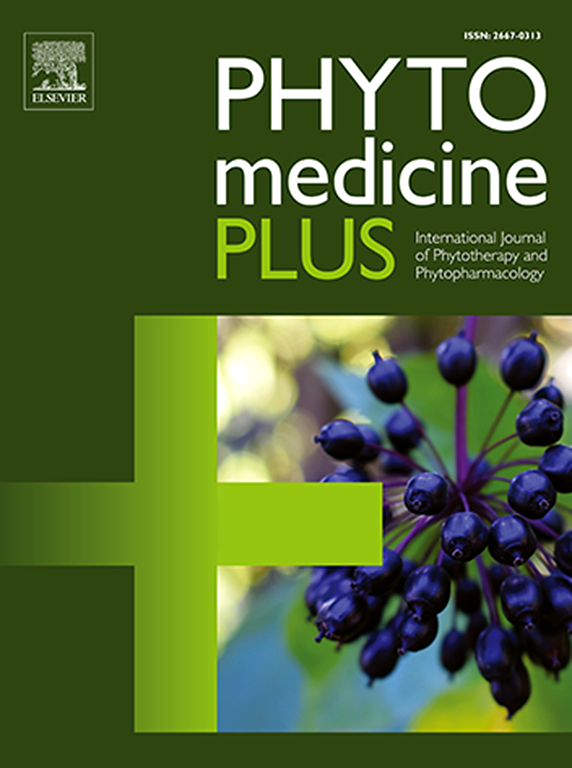Nymphaea pubescens Willd. extract and its flavonoid constituents vasodilate rat isolated pulmonary artery via NO-sGC-cGMP pathway
Q3 Pharmacology, Toxicology and Pharmaceutics
引用次数: 0
Abstract
Background
Pulmonary arterial hypertension (PAH) is a progressive disorder indicated by elevated blood pressure in pulmonary artery (PA). PAH treatment focuses on inducing PA vasodilation by inhibiting phosphodiesterase 5 (PDE5), the enzyme prominently expressed in pulmonary vasculature. Our previous research demonstrated that the extract (WLE) derived from the petals of the water lily (Nymphaea pubescens Willd.) and its flavonoid constituents, 3-methyl ether 3´-O-β-xylopyranoside (1), quercetin (2), and kaempferol (3), exhibited PDE5 inhibitory property, suggesting that WLE and its constituents may contribute to PA vasodilation.
Methods
Dried N. pubescens petals were extracted with 95 % ethanol to provide the WLE. The vasorelaxant effects of the WLE and its flavonoid constituents were evaluated on rat PA and aorta using organ bath technique. The cytotoxicity of the WLE was also tested on the vascular smooth muscle cells (VSMCs) isolated from PA and aorta. Furthermore, a molecular docking study was performed to confirm the binding mode of flavonoid constituents to PDE5.
Results
The WLE relaxed PA (EC50=4.96±0.81µg/ml) more than the aorta (EC50=27.50±7.61µg/ml, p < 0.001), suggesting its selectivity on the PA vs the aorta. PA vasorelaxation was reduced by endothelial removal or NG-nitro-l-arginine methyl ester (L-NAME), but was unaffected by indomethacin, apamin plus charybdotoxin, 4-aminopyridine (4-AP), glibenclamide, iberiotoxin, and BaCl2. 1H-[1,2,4]oxadiazolo[4,3-a]quinoxalin -1- one (ODQ) reduced the relaxation induced by the WLE (p < 0.05). Sodium nitroprusside (SNP)-induced relaxation was enhanced by the WLE. WLE had no effect neither on extracellular Ca2+ influx through ROCCs/VOCCs nor intracellular Ca2+ release from the sarcoplasmic reticulum. PE-induced contraction via α1-receptor was also unaffected by WLE. Compounds 1–3 relaxed both PA and aorta rings with and without endothelium (EC50=26 - >100 µM). VSMCs incubated with the WLE for 1 hr showed no acute cytotoxicity. The binding of compounds 1–3 to PDE5 is slightly better than that of native PDE5 inhibitors.
Conclusions
Both WLE and its flavonoids (1–3) vasodilated PA. The mechanism of WLE vascular action involved the endothelial nitric oxide (NO) pathway and stimulation of sGC, while showing no VSMC cytotoxicity.

柔毛若虫野生。提取物及其黄酮类成分通过NO-sGC-cGMP途径使大鼠离体肺动脉血管舒张
肺动脉高压(PAH)是一种以肺动脉(PA)血压升高为表现的进行性疾病。PAH的治疗重点是通过抑制肺血管中显著表达的磷酸二酯酶5 (PDE5)来诱导PA血管舒张。我们之前的研究表明,从睡莲(Nymphaea pubescens Willd.)花瓣中提取的提取物(WLE)及其类黄酮成分3-甲基醚3′-O-β-木pyranoside(1)、槲皮素(2)和山奈酚(3)具有抑制PDE5的特性,表明WLE及其成分可能有助于PA血管舒张。方法用95%乙醇提取干燥的短毛百合花瓣,提取WLE。采用脏器浴法对大鼠PA和主动脉的血管舒张作用进行了评价。并对PA和主动脉血管平滑肌细胞(VSMCs)进行了细胞毒性试验。此外,我们还进行了分子对接研究,以确定类黄酮成分与PDE5的结合方式。结果WLE松弛PA (EC50=4.96±0.81µg/ml)高于主动脉(EC50=27.50±7.61µg/ml, p <;0.001),提示其对肺动脉和主动脉的选择性。内皮细胞去除或ng -硝基-l-精氨酸甲酯(L-NAME)可降低PA血管舒张,但吲哚美辛、apamin + charydotoxin、4-氨基吡啶(4-AP)、格列本脲、iberiotoxin和BaCl2对PA血管舒张无影响。1H-[1,2,4]恶二唑[4,3-a]喹啉-1- 1 (ODQ)降低WLE引起的松弛(p <;0.05)。硝普钠(SNP)诱导的松弛作用在WLE作用下增强。WLE对通过rocc /VOCCs的细胞外Ca2+内流和肌浆网的细胞内Ca2+释放均无影响。pe通过α1受体诱导的收缩也不受WLE的影响。化合物1-3可使带内皮和不带内皮的PA和主动脉环松弛(EC50=26 - 100µM)。与WLE孵育1小时的VSMCs未表现出急性细胞毒性。化合物1-3与PDE5的结合略好于天然PDE5抑制剂。结论白藜芦醇及其类黄酮(1-3)均具有血管舒张作用。WLE的血管作用机制涉及内皮一氧化氮(NO)途径和sGC的刺激,而无VSMC细胞毒性。
本文章由计算机程序翻译,如有差异,请以英文原文为准。
求助全文
约1分钟内获得全文
求助全文
来源期刊

Phytomedicine Plus
Medicine-Complementary and Alternative Medicine
CiteScore
3.70
自引率
0.00%
发文量
178
审稿时长
81 days
期刊介绍:
 求助内容:
求助内容: 应助结果提醒方式:
应助结果提醒方式:


